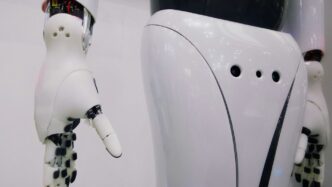The Evolution of Humanoid Images: From Sci-Fi Dreams to Tangible Reality
Imagining Humanoids: The Sci-Fi Blueprint
For decades, science fiction has painted vivid pictures of humanoid robots. Think of C-3PO from Star Wars, always ready with a protocol-driven remark, or Lieutenant Commander Data from Star Trek, striving for humanity. These characters weren’t just entertainment; they were early visions of what machines could be. They showed us robots that could think, interact, and even feel, sparking our imagination about a future where humans and artificial beings coexist.
These fictional portrayals often explored:
- Companionship: Robots as loyal friends or assistants.
- Exploration: Machines venturing into dangerous territories humans couldn’t.
- Labor: Automating tasks, both simple and complex.
These stories planted the seed for what we now see developing in real-world robotics.
Bridging the Gap: Sci-Fi Inspiration for Engineering
It might seem like a big leap from movie screens to actual workshops, but the influence of sci-fi on engineering is undeniable. The robots we saw in films and books gave engineers and scientists something to aim for. They provided a tangible goal, a kind of blueprint for what was possible. Concepts like advanced AI, human-like movement, and the ability to operate in tough conditions, all common in sci-fi, became the targets for real-world research and development.
Here’s how sci-fi has acted as a guide:
- Setting Aspirations: Fictional robots showed us what advanced capabilities might look like.
- Inspiring Design: Their forms and functions offered ideas for physical robot construction.
- Driving Innovation: The desire to replicate fictional abilities pushed technological boundaries.
Humanoid Robots: A Future Foretold
What was once just a plot device in a story is now becoming a reality. Companies and research institutions are actively building humanoid robots. These aren’t just clunky machines; they are increasingly sophisticated, designed to perform tasks that were once only imagined. From assisting in space exploration to potentially helping out in factories and homes, the future depicted in science fiction is starting to unfold before our eyes. The journey from imaginative tales to actual working robots is a testament to human ingenuity and our persistent drive to create.
Pioneering Humanoid Robots in Space Exploration
NASA’s Groundbreaking Humanoid Initiatives
For a long time, space exploration has been a big dream, often shown in science fiction movies. Think about robots helping astronauts on distant planets or fixing spaceships. Well, that dream is starting to look a lot like reality, thanks to places like NASA. They’ve been working on robots that can actually go into space and help out.
NASA has been a leader in this area for a while. They partnered with General Motors on the Robonaut project. This was one of the first tries at making robots that could work right alongside human astronauts. Robonaut 2, or R2, made it to the International Space Station back in 2011. The idea was for R2 to do jobs that were either too risky or just too boring for people. This could be anything from flipping switches to carefully handling scientific tools. Doing these kinds of tasks helps keep the astronauts safer.
R2 was pretty impressive. It had 43 different ways it could move, which is called degrees of freedom. This meant it could use tools made for humans pretty well. The work done with R2 really set the stage for later projects. One of those is Valkyrie, also known as R5. This robot is even more advanced, with 44 degrees of freedom. The plan is for robots like Valkyrie to help out on future missions, maybe even to Mars.
Robonaut and Valkyrie: Paving the Way
Robonaut 2’s time on the International Space Station (ISS) taught NASA a lot. They learned how to make robots that can handle the messy, unpredictable conditions of space and work in places designed for humans. The lessons learned from R2 are super important as they keep developing these machines. It’s like the old sci-fi stories are actually giving engineers ideas for what to build next.
Here’s a quick look at what makes these robots special:
- Dexterity: They are designed to use tools and perform tasks that require fine motor skills, much like a human hand.
- Adaptability: They need to work in environments not built for them, adapting to different tools and situations.
- Safety: Their primary role is to take on dangerous or repetitive tasks, reducing risk for human crews.
Advancements in Space-Ready Humanoid Design
Building robots for space is tough. They have to be tough themselves, able to handle extreme temperatures, radiation, and the vacuum of space. NASA’s work on Valkyrie, for example, focused on making a robot that could potentially operate on Mars. This means it needs to be able to walk, climb, and manipulate objects in a very different environment than Earth.
Think about the challenges:
- Power: Robots need a lot of energy, and getting that reliably in space is a big hurdle.
- Autonomy: While they can be controlled remotely, they also need to be able to think and act on their own when communication delays are too long.
- Durability: Space is harsh. Equipment needs to withstand extreme conditions without breaking down.
These robots are not just copies of humans; they are being built with specific space missions in mind. The goal is to make them capable of doing things humans can’t easily do, or shouldn’t have to do, in the vastness of space. The ongoing development of these advanced humanoid robots is a clear sign that the future of space exploration will involve close teamwork between people and machines.
New Frontiers: Tesla and Figure AI’s Ambitious Humanoid Projects
While NASA has been laying the groundwork for humanoid robots in space for years, some big tech companies are now jumping into the race with some pretty wild ideas. It’s like they saw those old sci-fi movies and thought, ‘Hey, we can build that!’
Tesla’s Optimus: A Vision for Mars and Beyond
Remember when Tesla announced Optimus, also known as the Tesla Bot? That was back in 2021, and the whole idea was to create a humanoid robot that could actually work alongside people, not just in factories, but maybe even out in space. Elon Musk has talked about these robots eventually going to Mars. The plan is to make thousands of them, with some potentially heading to the Red Planet as early as 2026. Imagine that – robots helping humans explore another planet. It sounds like something straight out of a movie, but Tesla seems pretty serious about it.
Here’s a quick look at what they’re aiming for:
- Initial Focus: Industrial tasks and manufacturing.
- Long-Term Goal: Assisting human explorers on Mars.
- Production Target: Thousands of units by 2025, with potential Mars deployment by 2026.
Figure AI’s Learning Humanoid Robots
Then there’s Figure AI. They’re a newer player, but they’ve got a robot called Figure-01 that’s getting a lot of attention. Their big goal is to make robots that can actually learn and think a bit like humans do. They’re not just talking about a few robots either; they want to produce a massive number – like 100,000 units in the next few years. That’s a huge number, and it shows how fast things are moving in this field.
- Robot Name: Figure-01
- Key Feature: Designed for learning and human-like reasoning.
- Production Goal: 100,000 units in the coming years.
Accelerating Humanoid Robot Production
What’s really striking about both Tesla and Figure AI is their sheer ambition when it comes to how many robots they want to build. It’s not just about making one or two cool prototypes; it’s about mass production. This rapid pace suggests that humanoid robots might become a lot more common, a lot sooner than we thought. They could end up helping with all sorts of jobs, from fixing things on a spaceship to doing complex science experiments in really tough places. It feels like we’re on the edge of seeing these sci-fi dreams become a real part of our future, especially when it comes to exploring the final frontier.
Challenges and Innovations in Humanoid Robotics
Building these advanced humanoid robots isn’t exactly a walk in the park. There are some pretty big hurdles to clear, both in terms of what the robots can do and how we make them work reliably. It’s a mix of tough engineering problems and figuring out how to make them smart enough for the real world.
Overcoming Environmental Hurdles in Space
Space is, well, harsh. Think extreme temperatures, radiation that can fry electronics, and that whole microgravity thing. Making robots that can handle this is a massive design challenge. We’re talking about using special materials that can take a beating and systems that can adapt to changing conditions. For instance, a robot designed for Mars needs to deal with dust storms and rocky terrain, which is way different from a factory floor. It’s not just about making them tough; it’s about making them adaptable.
The Role of AI and Machine Learning
This is where things get really interesting. For a humanoid robot to be useful, especially in unpredictable places like space or a busy factory, it needs to be smart. Artificial intelligence and machine learning are key to giving these robots the ability to learn and make decisions on their own. Right now, many robots still need a human to guide them through tricky situations. The goal is to get them to a point where they can figure things out, like how to pick up an oddly shaped object or react safely if something unexpected happens. This involves a lot of data and clever programming.
Ensuring Robustness and Adaptability
Beyond just being smart, these robots need to be dependable. Imagine a robot on a spacewalk – it can’t just break down. That means building them with parts that are less likely to fail and designing them so they can keep working even if one system has a hiccup. It’s about creating robots that are not only capable of performing tasks but can also do so consistently and safely, adapting to whatever the environment throws at them. This also means making sure all the different parts – the sensors, the motors, the software – work together smoothly. It’s a complex puzzle, but the progress we’re seeing is pretty amazing.
The Symbiotic Future of Humans and Humanoid Robots

Expert Insights on Human-Robot Collaboration
It’s pretty wild to think about, but the robots we see in movies, the ones that help out astronauts or explore new planets, are actually starting to become real. Experts are saying that the future of space missions isn’t just about humans or robots, but about them working together. This partnership is going to change how we do everything out there. Think about it: robots can handle the really dangerous stuff, the repetitive tasks, or the ones that need super steady hands, while humans can focus on the big picture, the creative problem-solving, and the decision-making that requires that human touch. It’s like having a super-powered assistant for every astronaut.
Redefining Space Mission Efficiency and Safety
When robots can do more on their own, missions get a whole lot smoother and safer. Imagine a robot on Mars that can collect samples, run tests, and even fix equipment without needing constant instructions from Earth. That saves time, reduces the risk of human error, and means we can get more science done. It’s not just about having a helper; it’s about making space exploration more effective. Here are a few ways this collaboration is shaping up:
- Task Delegation: Robots take on hazardous or repetitive jobs, like spacewalk repairs or sample collection in extreme conditions.
- Data Gathering: Advanced sensors on robots can collect vast amounts of data that humans might miss or find difficult to process.
- Emergency Response: Humanoid robots can act quickly in unexpected situations, providing immediate assistance or securing an area.
Complementary Capabilities in Exploration
What makes this human-robot team-up so promising is how different their strengths are. Humans are great at adapting to new situations, thinking outside the box, and understanding complex social cues (though that last one might be less relevant for robots right now!). Robots, on the other hand, excel at precision, endurance, and operating in environments that are just too tough for us. This means:
- Precision Tasks: Robots can perform intricate repairs or scientific procedures with a level of accuracy humans can’t match.
- Endurance: They can work for extended periods without fatigue, crucial for long-duration missions.
- Environmental Tolerance: Robots can operate in extreme temperatures, radiation, or low-gravity environments that would be harmful or impossible for humans.
The Economic Impact of Humanoid Robots
It’s pretty wild to think about how much humanoid robots could shake up our economy. We’re talking about a potential shift that could be massive, not just a small change. A lot of this excitement comes from the fact that many countries are facing a shrinking workforce. Think about it: fewer people are available to do the jobs that need doing, especially the tough, repetitive, or even dangerous ones. Humanoid robots are seen as a way to fill that gap.
Addressing Global Labor Shortages
This is a big one. As populations age and birth rates drop in many parts of the world, the number of people available for work is going down. This isn’t just a future problem; it’s happening now. Some reports suggest that in Europe, for example, the working-age population could shrink by a noticeable amount in the coming decades. At the same time, the need for goods and services keeps growing, and supply chains are getting more complicated. Humanoid robots could step in to help keep production going and improve how efficiently things are made. They could also take on tasks that are just too risky or unpleasant for humans to do regularly.
Potential for Multi-Trillion Dollar Markets
So, how big could this market get? Some analysts are predicting truly enormous figures. If we see rapid development and widespread adoption of these robots, the market could reach into the trillions of dollars annually. Imagine millions of these robots working across various industries by the year 2050. That’s a lot of economic activity. Of course, this optimistic view depends heavily on technology continuing to advance quickly and on governments figuring out the rules and regulations for these machines.
Here’s a look at some potential market growth:
| Year | Estimated Humanoid Robots | Estimated Annual Revenue |
|---|---|---|
| 2050 | 50 million | USD 1.5 trillion |
Navigating Technical and Regulatory Landscapes
It’s not all smooth sailing, though. Right now, most humanoid robots are still in the early stages, like prototypes. There are significant hurdles to overcome. Development costs are high, the technology is complex, and there’s a lot of uncertainty about how they’ll be regulated. We need robots that can move reliably, react quickly to unexpected things, and communicate clearly. Plus, they need to be able to learn and adapt. This means a lot of work on everything from their ‘bones’ and ‘muscles’ (skeletons and actuators) to their ‘brains’ (AI and software) and power sources. Getting all these different parts to work together perfectly is a huge engineering challenge. Without solving these technical issues and establishing clear rules, the dream of a multi-trillion dollar market might just stay a niche business.
The Future is Almost Here
So, we’ve seen how robots that look and act like us went from cool ideas in movies to actual machines being built today. It’s pretty wild to think about. Companies like NASA, Tesla, and others are really pushing to make these robots work in tough places, like space. Sure, there are still big hurdles, like making sure they have enough power and can think for themselves in tricky situations. But honestly, the progress is happening so fast. It feels like those sci-fi stories we grew up with are actually starting to come true. It’s exciting to imagine these robots helping us explore the stars and maybe even making life easier right here on Earth. Keep an eye out, because the future with these human-like machines is closer than you might think.














